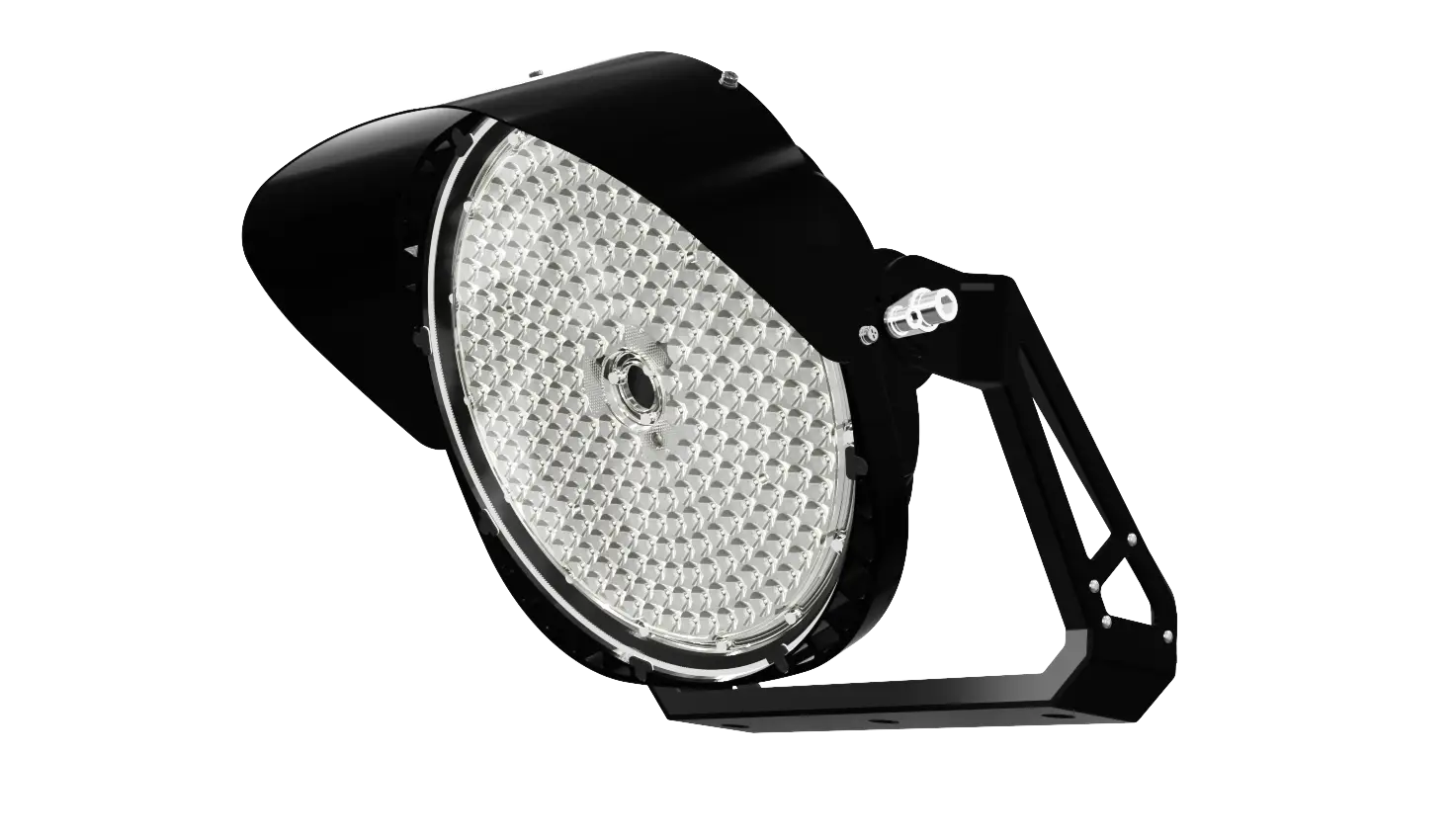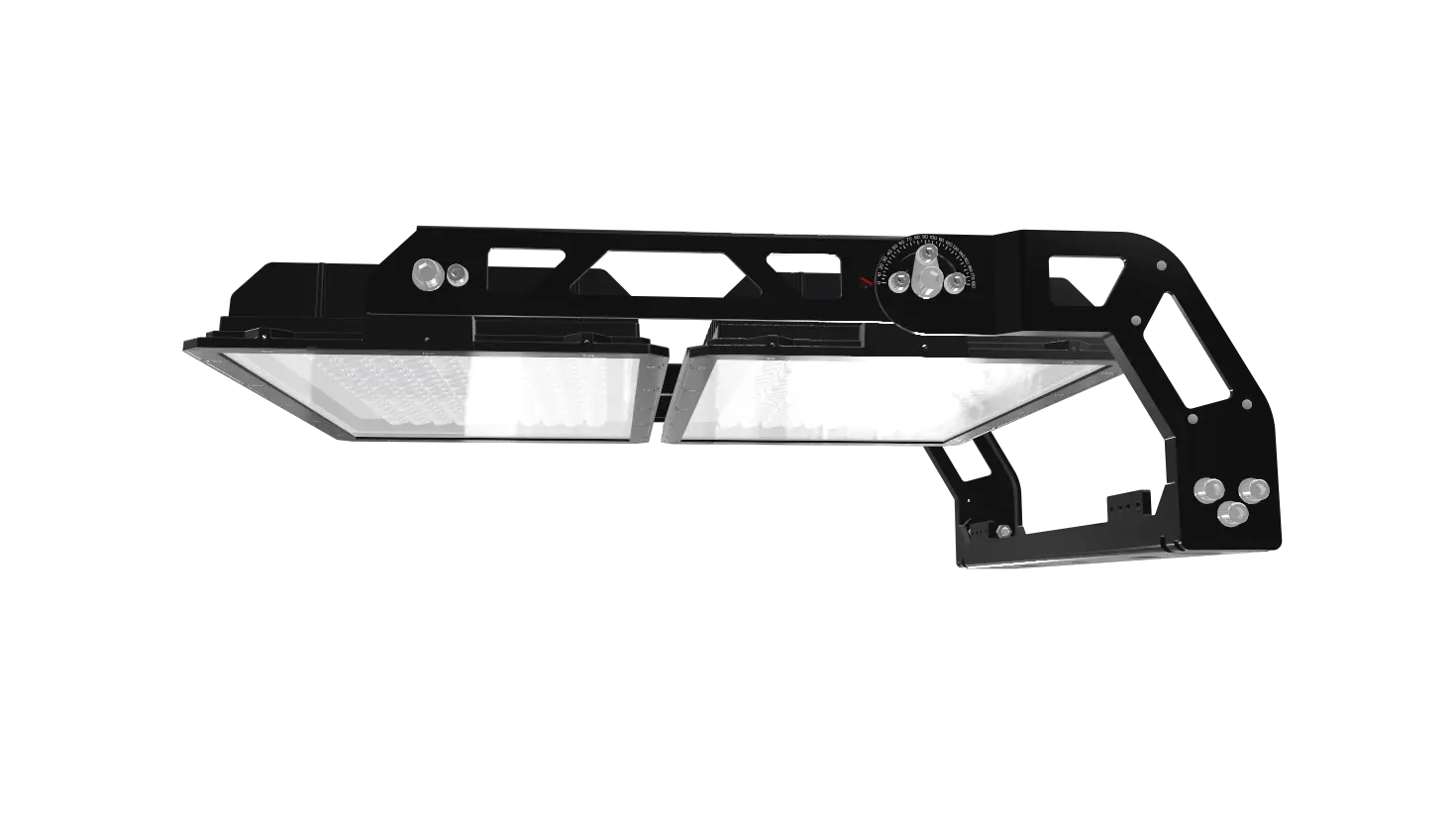Why You Should Choose LED Baseball Field Lights?
Illumination is make-or-break for baseball games—it keeps players safe, boosts performance, and lets fans follow every play. But outdated setups like metal halide lights? They take 15-20 mins to warm up, waste 30% more energy, and burn out fast. That's why LED baseball field lights are taking over: they're bright, energy-efficient, and built to last for years.
This guide breaks down the key reasons to choose LEDs, plus how to pick the right lumens for your field (Little League, pro, or recreational), so you can make a smart, long-term choice.
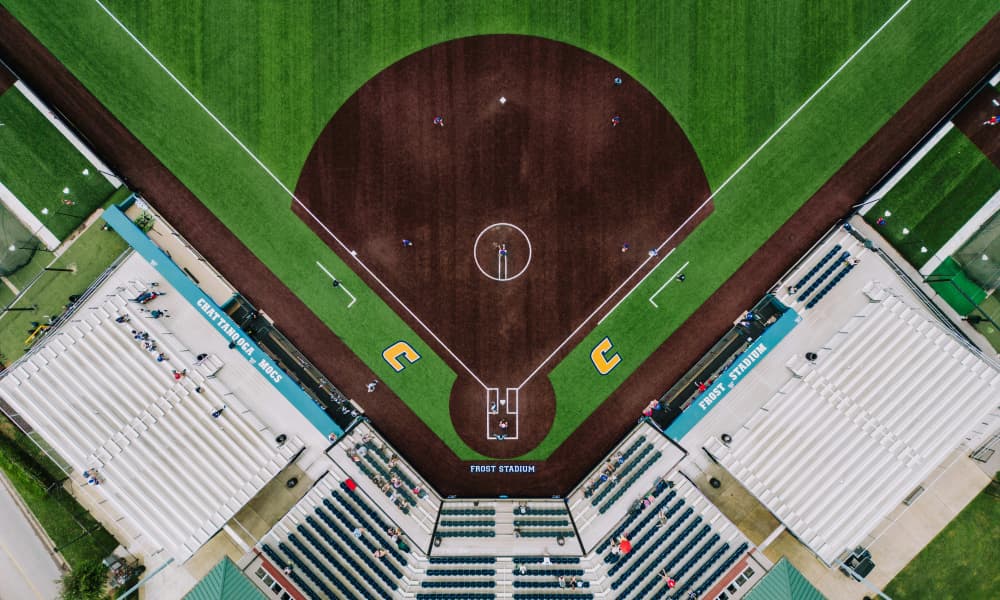
Table of Contents
What are LED Baseball Field Lights?
Traditional Lighting vs LED Lighting for Sports Fields
Why Choose LED Lighting for Baseball Field?
How To Choose the Best LED Baseball Field Lights?
How Much do Baseball Field Lights Cost?
Baseball Field Lighting Design & Installation
What are LED Baseball Field Lights?
LED baseball field lights are high-output floodlights specifically engineered to brighten the entire playing area. Unlike older metal halide lamps, these LED fixtures deliver instant full brightness, offer superior energy utilization, and boast a significantly longer service life.
To achieve even light distribution across the field, these LED lights are installed on the venue's light poles. Their mounting height and projection angles are carefully calculated beforehand. Well-designed lighting systems effectively minimize harsh glare, reduce shadowed zones, and eliminate dark spots—creating a secure competitive environment for athletes.
Modern baseball field lights also feature precise beam control capabilities. Leveraging this function, the fixtures can meet the strict illumination requirements of baseball fields while cutting energy consumption by approximately 60%.
Additionally, they come with robust housings and strong weather resistance, allowing them to operate reliably whether in small community park fields or large-scale professional sports venues.
In summary, LED baseball field lights combine powerful illumination, excellent energy-saving performance, and consistent light output—establishing themselves as an ideal option for current baseball field lighting setups and the upgrade of older lighting systems.
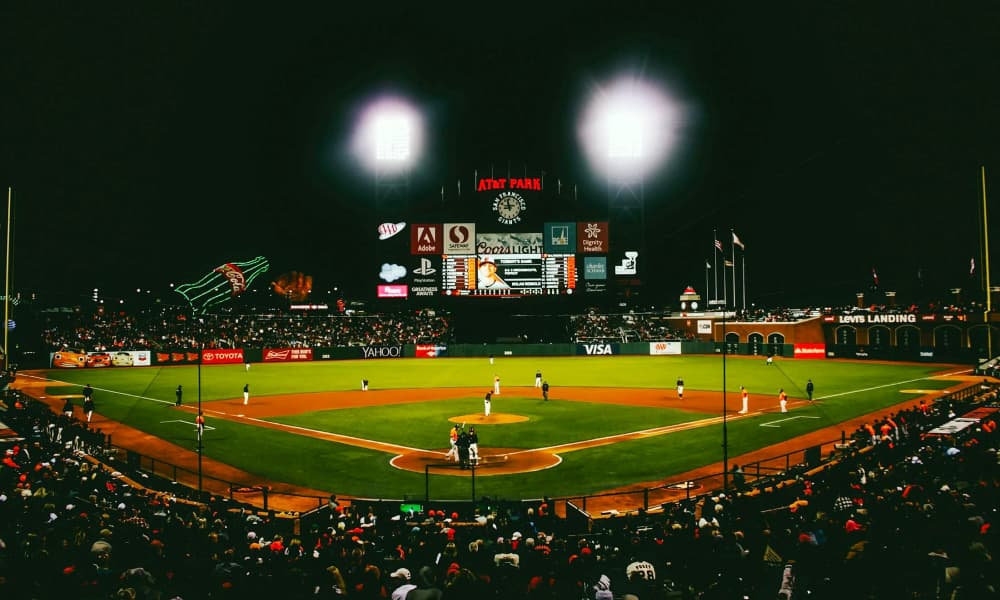
Traditional Lighting vs LED Lighting for Sports Fields
Baseball fields have long relied on traditional High-Intensity Discharge (HID) lamps, mainly Metal Halide (MH) and High-Pressure Sodium (HPS). While these systems once set the standard, they also came with significant drawbacks.
l MH lamps delivered bright white light but suffered from long warm-up times and rapid lumen depreciation.
l HPS lamps provided better efficiency but cast a yellow-orange glow with poor visibility and color rendering.
With the rising demands for visibility, energy efficiency, and lower maintenance, these older technologies are increasingly being replaced by LED baseball field lights. LEDs not only overcome the limitations of MH and HPS but also add new advantages such as instant startup, higher light quality, and significantly longer lifespans.
The following comparison highlights the core differences among MH, HPS, and LED solutions for baseball fields:
Comparison: MH vs HPS vs LED

In short, LED baseball field lights clearly outperform both MH and HPS by combining efficiency, durability, and superior visibility—making them the modern standard for sports lighting upgrades.
Why Choose LED Lighting for Baseball Field?
Switching to LED baseball field lights is not just about technology—it's about practical benefits for operators, players, and spectators.
(1) Lower Operating Costs
LEDs cut energy consumption by up to 70% compared with HID or MH lamps. For a community field, this can mean thousands of dollars saved every season. Reduced power use also supports sustainability goals.
(2) Minimal Maintenance
With lifespans reaching 50,000–100,000 hours, LEDs require far fewer replacements than traditional lamps. Fewer bulb changes mean less downtime and lower maintenance expenses.
(3) Better Playing Conditions
LEDs deliver consistent brightness and high color rendering (CRI). Players track the ball more easily, and night games feel closer to daytime conditions. Shadows and dark spots are minimized, improving safety on the field.
(4) Improved Spectator Experience
Uniform lighting enhances visibility from the stands and for live broadcasts. Fans see the action clearly without glare or flicker, making games more enjoyable.
(5) Flexible Control
LED systems integrate with smart controls, allowing operators to adjust brightness for practice, official games, or special events. Dimming, zoning, and scheduling are all possible—something older systems cannot match.
(6) Future-proof Investment
Although the upfront cost is higher, the long-term savings on energy and maintenance deliver a strong return. Many facilities recoup their investment within a few years.
In short, choosing LED lighting for baseball fields means safer games, lower bills, and a better fan experience.
How To Choose the Best LED Baseball Field Lights?
Choosing the right LED baseball field lights is not just about picking a fixture—it's about matching your field type, competition level, and long-term budget. Here’s how to make a smart choice.
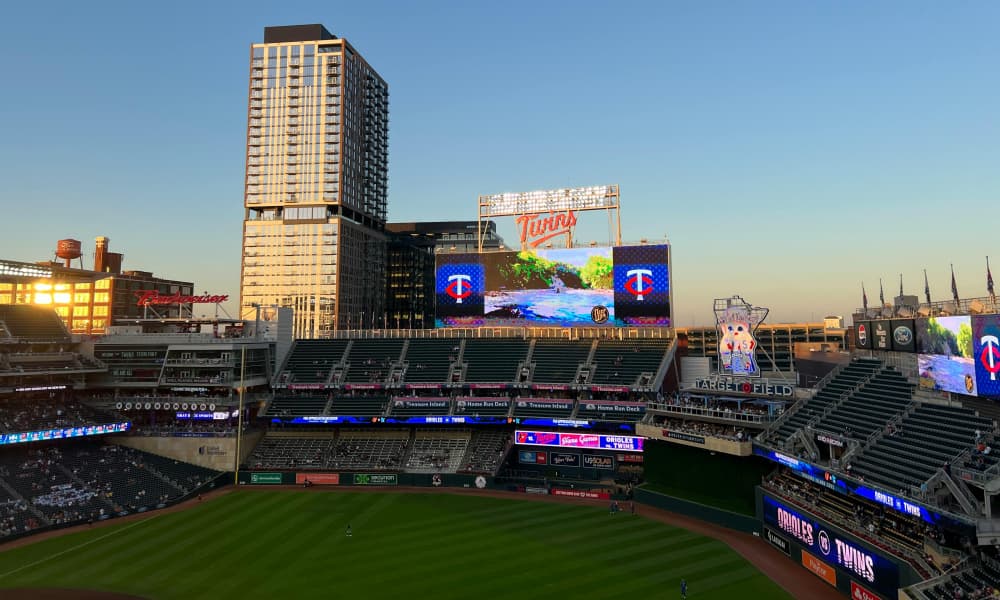
① Define Field Type and Competition Level
Lighting needs vary by level of play:
l Recreational / Little League: 30–50 foot-candles, typically 20–30 fixtures.
l High School / College: 50–70 foot-candles, around 30–60 fixtures.
l Professional Stadiums: 70–100+ foot-candles, often 100+ fixtures.
Knowing your level sets the baseline for brightness and fixture count.
② Match Wattage and Lumens
Look at lumens, not watts. For example, a 1,200W LED fixture can produce 160,000+ lumens. Recreational fields may need a total of 1.5–2 million lumens, while pro-level stadiums can exceed 8 million lumens. Always balance fixture output with pole placement.
③ Beam Angle and Optics
Narrow beams (15–30°) cover long throws from tall poles, while wide beams (40–60°) spread light across the infield or spectator zones. A mixed-beam design ensures uniform coverage with no shadows.
④ Pole Height and Placement
Typicalpole heights range from 40–100 ft. Smaller fields use 40–60 ft, while stadiums often require 80–100 ft. Correct spacing and aiming are just as important as height to avoid glare and hotspots.
⑤ Durability and Protection
Outdoor baseball field LED lights must handle rain, dust, and wind. Look for IP65+ protection and corrosion-resistant housings. In coastal regions, choose salt-resistant finishes to extend service life.
⑥ Control Options
Modern systems offer dimming, timers, and remote controls. Smart management can reduce operating costs by 10–20% annually, improving ROI.
⑦ Compliance with Standards
Always check IES or CIE lighting guidelines. A professional photometric design ensures your field meets safety and visibility standards before installation.
Below is a quick checklist. By following this path, you’ll select LED baseball field lights that deliver lasting performance, energy savings, and professional visibility.
Field Type / Level | Target Foot-Candles | Total Lumens Needed | Fixture Count (Approx.) | Pole Height Range |
Recreational / Little League | 30–50 fc | 1.5M – 2M | 20–30 | 40–60 ft |
High School / College | 50–70 fc | 3M – 5M | 30–60 | 60–80 ft |
Professional Stadium | 70–100+ fc | 6M – 8M+ | 100+ | 80–100 ft |
How Much do Baseball Field Lights Cost?
The cost of LED baseball field lighting depends on several factors: the size of the field, the level of play, the number of fixtures required, and installation complexity. Beyond purchase price, long-term savings on energy and maintenance also affect the total cost of ownership.
1. Initial Purchase & Installation Costs
① Fixture Price: A single high-quality LED sports light (1000–1500W equivalent) typically ranges from $800 to $2,000 per unit.
② Number of Fixtures:
l Little League fields (60–70 ft bases) usually require 20–30 fixtures.
l High school/college fields (90 ft bases, larger outfield) need 30–40 fixtures.
l Professional fields may require 60+ fixtures to meet broadcast-level lighting standards.
③ Poles & Mounting: Poles, brackets, and cabling add significant cost, often accounting for 30%–40% of the total budget.
④ Installation Labor: Professional installation (pole erection, wiring, aiming) can add another $20,000–$50,000, depending on the site conditions.
On average, a Little League field may cost $80,000–$120,000 for a full LED system, while a professional stadium can exceed $500,000.
2. Operating & Maintenance Costs
Energy Consumption: LED lights use 40%–60% less electricity than metal halide or HPS lamps. A full field setup may consume 30–50 kW per game, compared to 60–100 kW with traditional lights.
Maintenance: LEDs offer 50,000–100,000 hours of lifespan, reducing the need for frequent bulb replacement and lift-truck rental. Over a decade, this can save tens of thousands of dollars compared to traditional systems.
3. Return on Investment (ROI)
Switching to LED is not only about better lighting—it’s also a financial decision.
① Energy Savings: Lower power bills quickly add up. A mid-sized field can save $10,000–$20,000 annually on electricity.
② Reduced Maintenance: Avoiding frequent bulb replacements and labor reduces annual expenses by another $5,000–$10,000.
③ Payback Period: Most fields see a 3–6 year ROI, after which the system continues delivering savings.
Added Value: Brighter, uniform, and flicker-free lighting enhances player performance, fan experience, and even broadcasting opportunities—indirectly contributing to revenue growth.
Baseball Field Lighting Design & Installation
Designing and installing LED lighting for a baseball field is more than just putting fixtures on poles—it requires a balance of engineering, safety, and visual performance. The goal is to achieve uniform brightness, minimal glare, and reliable coverage across the infield and outfield.
Below are the most common mounting and installation methods used for baseball field lights.
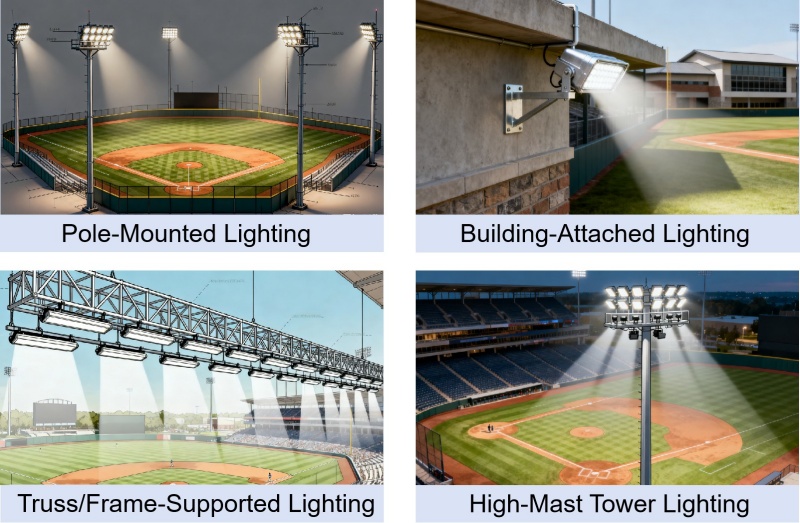
1. Pole-Mounted Lighting
l Most common solution for community, school, and semi-professional fields.
l Poles are typically 40–100 ft tall, depending on field size and level of play.
l Materials include galvanized steel or aluminum to withstand wind, rain, and long-term exposure.
l Fixtures are mounted at specific angles (usually 15°–60° beam angles) to avoid shadows and provide smooth coverage.
l For small fields (Little League), 4–6 poles may be enough, while full-size stadiums require 6–8 or more.
Advantage: Flexible for different field sizes, cost-effective for schools and community sports.
Limitation: Requires sufficient space around the field perimeter.
2. Wall- or Roof-Mounted Lighting
l Used when the field is close to school buildings, gym walls, or nearby structures.
l Eliminates the need for poles, reducing installation cost and space requirements.
l Works well for smaller training fields or urban locations where space is limited.
Advantage: Saves pole installation cost.
Limitation: Limited mounting height may reduce lighting uniformity for larger fields.
3. High-Mast Tower Lighting
l Ideal for multi-purpose stadiums or larger baseball complexes.
l Poles or towers can reach 150–250 ft, allowing a wide beam spread across the entire field.
l High masts often support multiple fixtures per tower, reducing the number of poles required.
Advantage: Excellent coverage, fewer poles needed.
Limitation: Higher upfront cost and engineering requirements.
4. Truss or Frame-Mounted Lighting
l Common in college and professional stadiums where poles near the field would obstruct sightlines.
l Fixtures are mounted on roof trusses, structural frames, or catwalks above the stands.
l Provides excellent lighting angles from above, ensuring uniform illumination for both players and broadcast cameras.
Advantage: No poles on the field perimeter, better viewing experience for fans.
Limitation: Only suitable for large stadiums with strong structural support.
5. Key Design Considerations
l Beam Angle & Positioning: Avoids shadows and dark spots in the outfield.
l Uniformity Ratio: Target of 0.5 or higher ensures balanced light across the field.
l Glare Control: Anti-glare lenses and shielded optics help protect players’ and spectators’ eyes.
l Weather Durability: Fixtures must be IP65+ rated to resist rain, wind, and dust.
Wiring & Power: Underground conduits and weatherproof connections ensure safety and reliability.
Conclusion
LED baseball field lights have become the clear choice for modern sports facilities. Compared with traditional HID, metal halide, or high-pressure sodium lamps, LEDs deliver higher efficiency, longer lifespan, and far lower maintenance. They also provide consistent brightness and meet strict baseball field lighting standards for both infield and outfield play.
From cost savings on energy to flexible design options with poles, masts, or trusses, LEDs make it easier to achieve professional-level visibility. Whether planning for a local league, high school, or professional stadium, the right design ensures proper lumen output, correct mounting height, and uniform coverage.
Investing in LED baseball field lights is not just a short-term upgrade—it is a long-term solution that improves player safety, spectator experience, and operational efficiency.
FAQs
1. How Many Lumens Are Needed to Light a Baseball Field?
The lumen requirement depends on the competition level. Little League or recreational fields may need 30,000–50,000 lumens per fixture, while high school and college fields often require 70,000–100,000 lumens per fixture. Professional stadiums with TV broadcasting can exceed 200,000 lumens per fixture. The goal is to reach 30–100 foot-candles on the infield and 20–50 foot-candles on the outfield.
2. What's the Best Height to Mount Baseball Field Lights?
For small fields, poles are typically 40–60 ft high. High school or community fields often use 60–80 ft poles. Large stadiums can reach 100 ft or more to achieve better coverage and reduce glare. The correct height depends on beam angle, pole location, and field size. Mounting too low can create shadows, while excessive height reduces efficiency.
3. How Many Stadium Lights Are Needed for a Baseball Field?
The number of lights depends on the field size and competition level. A Little League field may use 20–30 fixtures, while high school or college fields often require 30–60 fixtures. Professional stadiums can need 100+ fixtures mounted across poles, masts, or trusses. The layout matters as much as the count—uniform placement around the infield and outfield ensures players never lose sight of the ball.
4. How Much Does It Cost to Run Baseball Field Lights?
Running costs depend on wattage, fixture count, and usage hours. A typical high school field with 40 LED fixtures at 1,200W each consumes about 48 kW per hour. At $0.12 per kWh, that’s roughly $6 per hour.
Older metal halide systems could cost 2–3 times more due to higher wattage and inefficiency. LED lights cut operating costs significantly, especially when combined with dimming controls and scheduled operation.
Related Product
_thumb.jpg)
